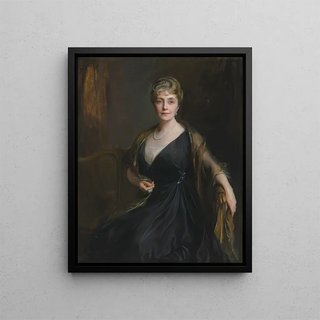Art print | Lady Orr-Lewis née Maude Helen Mary Booth - Philip Alexius de László


View from behind

Frame (optional)
In the fascinating world of early 20th-century portrait painting, the art print "Lady Orr-Lewis née Maude Helen Mary Booth" by Philip Alexius de László stands out for its elegance and psychological depth. This portrait, executed with exceptional technical mastery, captures not only the external beauty of its subject but also an inner essence that seems to transcend time. The delicacy of features, the finesse of details, and the harmony of colors invite the viewer to immerse themselves in a world where art and life meet with grace. This iconic art print is a true homage to the woman who is the model, while also reflecting the refined aesthetic of her era.
Style and uniqueness of the work
The style of Philip Alexius de László is characterized by a realistic approach, imbued with a particular sensitivity to the character of his models. In "Lady Orr-Lewis née Maude Helen Mary Booth," the artist deploys a palette of delicate colors, where flesh tones subtly blend with darker background hues. This chromatic choice helps to highlight the luminosity of Lady Orr-Lewis's face, thus accentuating her penetrating gaze and expression filled with serenity. The composition, balanced and harmonious, directs the viewer’s attention to the face of the model, while revealing details of her dress, carefully crafted. Every element, from the sparkling jewelry to the folds of fabric, demonstrates a meticulous attention to detail that has made László’s reputation. This portrait is not merely a simple representation; it evokes a story, a personality, a life.
The artist and his influence
Philip Alexius de László, born in 1869 in Hungary, is one of the most sought-after portraitists of his time. His career led him to paint members of royalty, aristocrats, and influential personalities across Europe and beyond. László succeeded in establishing himself thanks to a style that combines tradition and modernity, drawing inspiration from the great masters while developing a personal signature. His work has influenced many contemporary artists

Matte finish

View from behind

Frame (optional)
In the fascinating world of early 20th-century portrait painting, the art print "Lady Orr-Lewis née Maude Helen Mary Booth" by Philip Alexius de László stands out for its elegance and psychological depth. This portrait, executed with exceptional technical mastery, captures not only the external beauty of its subject but also an inner essence that seems to transcend time. The delicacy of features, the finesse of details, and the harmony of colors invite the viewer to immerse themselves in a world where art and life meet with grace. This iconic art print is a true homage to the woman who is the model, while also reflecting the refined aesthetic of her era.
Style and uniqueness of the work
The style of Philip Alexius de László is characterized by a realistic approach, imbued with a particular sensitivity to the character of his models. In "Lady Orr-Lewis née Maude Helen Mary Booth," the artist deploys a palette of delicate colors, where flesh tones subtly blend with darker background hues. This chromatic choice helps to highlight the luminosity of Lady Orr-Lewis's face, thus accentuating her penetrating gaze and expression filled with serenity. The composition, balanced and harmonious, directs the viewer’s attention to the face of the model, while revealing details of her dress, carefully crafted. Every element, from the sparkling jewelry to the folds of fabric, demonstrates a meticulous attention to detail that has made László’s reputation. This portrait is not merely a simple representation; it evokes a story, a personality, a life.
The artist and his influence
Philip Alexius de László, born in 1869 in Hungary, is one of the most sought-after portraitists of his time. His career led him to paint members of royalty, aristocrats, and influential personalities across Europe and beyond. László succeeded in establishing himself thanks to a style that combines tradition and modernity, drawing inspiration from the great masters while developing a personal signature. His work has influenced many contemporary artists






